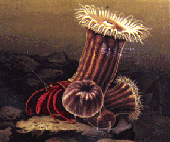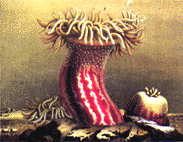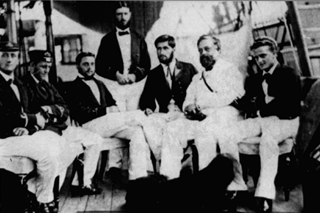
The Museum of Science and Art |
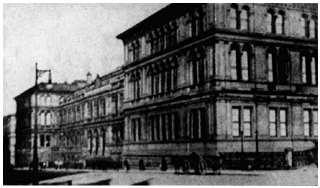
There were two main factors involved in this breakdown of relations between the two bodies. First, although the collection had been housed in the new building it had been agreed that the University could borrow specimens for teaching. Unfortunately, specimens were so often on loan that the collection became difficult to manage. Worse, many specimens were 'lost'. Secondly, a feeling developed in the museum that the University professors, who were still the curators of the collection, were neglecting their keepership duties. This feeling was strengthened when Allman's successor, Charles Wyville Thomson - an ex-student of Jameson - spent only two years in Edinburgh before sailing as Director of Scientific Staff on the famous expedition of H.M.S. Challenger (1872-76).
During Wyville Thomson's absence, a report from the Department of Science and Art stated that; "... the duties of the keeper of the Natural History Collections have never been fulfilled by the present professor ... who declined to perform them during the whole two years which he spent in Edinburgh". It was concluded that the department would appoint its own curator and the museum would continue as a body totally independent of the University. Having lost access to the second collection, the University now set about acquiring a third collection for its own use. In the early spring of 1871, an incident occurred that illustrates the failing relationship between the two bodies. As can still be seen today the Old College building is joined to the Royal Museum by an enclosed bridge -Edinburgh's "Bridge of Sighs".
It seems necessary here to offer an explanation for what must appear as lamentable behaviour on the part of Allman, Wyville Thomson and the University. This digression also helps to show how the study of animal biology has developed in the University during the last 130 years. Prior to Forbes' appointment in 1854, the Professors of Natural History had been generalists concerned with studies and lectures on animals, plants and minerals. Much time was spent, as we have seen, on collecting and describing new specimens and in revealing the enormous diversity of living organisms. Forbes' appointment, short though it was, was a turning point in the story of the chair of Natural History. From this time, its incumbents concentrated on animals. The mid to late nineteenth century was an exciting and productive period for those interested in animals. The exchange of information flourished throughout Europe via books, monographs and learned societies. Methods for studying animals, their physiology and behaviour developed. Above all, it was a time when the world was generally available for peaceful and scientific travel. Forty years before, in 1834, the voyage of H.M.S. Beagle had stimulated Darwin, in parallel with Wallace who had also travelled widely in South America and the Far East, to formulate revolutionary ideas on evolution.
The scientific results of this voyage were published in fifty volumes (London 1880-95) under the direction of Sir John Murray who had accompanied Wyville Thomson. Specialists in every branch of science studied the collection and data obtained by the voyage and assisted in the production of the reports. It is no exaggeration to suggest that with the voyage of the HMS Challenger, the science of oceanography was born. Taking into account the scientific climate of the Victorian age and the exceptional qualities of Allman and Wyville Thomson, is it really so surprising that both chose to pursue their own lines of research rather than serve as curators for collections amassed by their predecessors? Even though Wyville Thomson had left Edinburgh to sail on the HMS Challenger, the Department did not go into a state of hibernation. Two very eminent scientists presided over the Chair of Natural History, each for half of Wyville Thomson's four year voyage. Julius Victor Carus taught in the first two years and Thomas Henry Huxley, the famous comparative anatomist in the last two. |







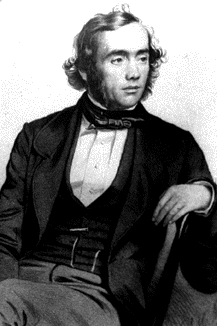 Sadly, neither Jameson nor his successor, Edward Forbes,
lived to see the collection re-housed in the new national
museum in 1866. Forbes had succeeded Jameson in 1854 but
died before the end of the year. It was George Allman,
Professor of Natural History from 1855-1870, who presided
over both these events and the rapid deterioration in
relationships between University and Museum which followed
on the removal of the collection to the new building next
door.
Sadly, neither Jameson nor his successor, Edward Forbes,
lived to see the collection re-housed in the new national
museum in 1866. Forbes had succeeded Jameson in 1854 but
died before the end of the year. It was George Allman,
Professor of Natural History from 1855-1870, who presided
over both these events and the rapid deterioration in
relationships between University and Museum which followed
on the removal of the collection to the new building next
door.

 On one particular evening, the museum was having a reception
party at which many Edinburgh dignitaries could be found.
Alcoholic refreshments for the guests and the reception band
were stored in the bridge. However, unknown to the museum
authorities and their guests, the Natural History students
were having a party of their own on the University's side of
the bridge. The students' festivities included stealing and
consuming every keg and bottle of the museum's stock leaving
the reception party totally without refreshment. Tempers,
understandably, flared and an enormous padlock was fixed to
the University door of the bridge. Since then, the bridge
has been used as an aquarium, a laboratory and is currently
employed as a storeroom for the museum, the padlocked door
having been replaced with a solid wall.
On one particular evening, the museum was having a reception
party at which many Edinburgh dignitaries could be found.
Alcoholic refreshments for the guests and the reception band
were stored in the bridge. However, unknown to the museum
authorities and their guests, the Natural History students
were having a party of their own on the University's side of
the bridge. The students' festivities included stealing and
consuming every keg and bottle of the museum's stock leaving
the reception party totally without refreshment. Tempers,
understandably, flared and an enormous padlock was fixed to
the University door of the bridge. Since then, the bridge
has been used as an aquarium, a laboratory and is currently
employed as a storeroom for the museum, the padlocked door
having been replaced with a solid wall.
